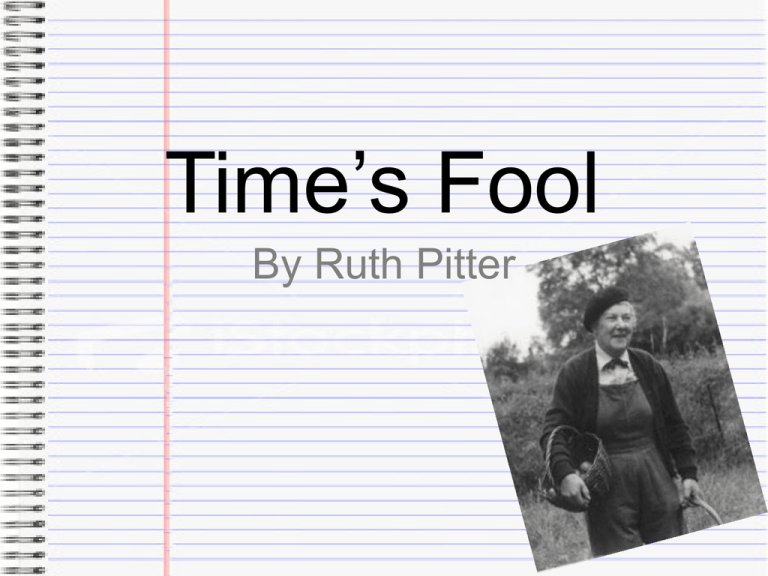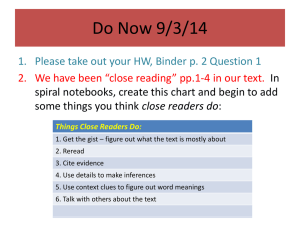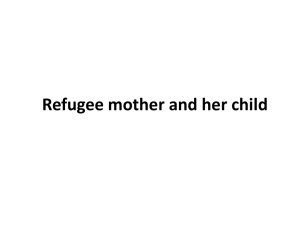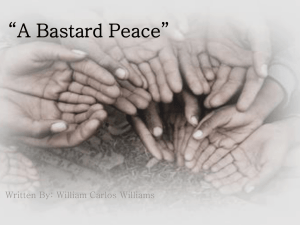Time`s Fool - asliteratureavcol
advertisement

Time’s Fool By Ruth Pitter Ruth Pitter • Born 1897 in Ilford, Greater London and died in 1992. • She was influenced at an early age to write poetry by her parents, George and Louisa Pitter, whom were both school teachers. • In 1920, she published her first book of poetry. • Pitter received numerous awards. In 1955, she was the first woman to receive the “Queen’s Gold Medal for Poetry” award. • She was well known for her contributions to BBC radio programmes. • One of the main key influences and inspiration was the natural world around her (which is noticeable in Time’s fool). Time’s fool, but not heaven’s: yet hope not for any return. The rabbit-eaten dry branch and the halfpenny candle Are lost with the other treasure: the sooty kettle Thrown away, become redbreast’s home in the hedge, where the nettle Shoots up, and bad bindweed wreathes rust-fretted handle. Under that broken thing no more shall the dry branch burn. Poor comfort all comfort: once what the mouse had spared Was enough, was delight, there where the heart was at home; The hard cankered apple holed by the wasp and the bird, The damp bed, with the beetle’s tap in the headboard heard, The dim bit of mirror, three inches of comb: Dear enough, when with youth and with fancy shared. I knew that the roots were creeping under the floor, That the toad was safe in his hole, the poor cat by the fire, The starling snug in the roof, each slept in his place: The lily in splendour, the vine in her grace, The fox in the forest, all had their desire, As then I had mine, in the place that was happy and poor. Themes/Main Ideas • Having things that people do not appreciate the beauty of and take it for granted where others would gladly have. – I think this is the main idea of the poem. Pitter tries to convey that unwanted objects that have little or no value are taken and then turned into something useful. • Finding happiness in the simplest of things. – Another idea is that the simple things that people disregard like “candles” or “kettles” can bring others, or in this case, animals happiness because they can turn it into a home. • Division between social classes. – Another thought that I came up with is that the animals sort of represent people of a lower class. It relates to the other themes/ideas of how these items are sort of ignored and disposed of by higher class societies and left for the lower classed people to make use of. Breakdown of the Poem • Pitter creates the imagery of animate vs. inanimate objects. – “The sooty kettle… become redbreast’s home in the hedge.” – “half penny candle” • Through this, she accomplishes to show that what people discard as useless (to them) may be beneficial to others. The way Pitter uses a number of animals/nature in the poem and how they are used in context expresses how they are sort of the ‘underdog’ who are neglected. – “Bad bindweed wreathes rust fretted handle.” • The alliteration in the line emphasizes how terrible and annoying bindweeds are but how they intertwine with the “handle”, the “handle” becomes a part of it and becomes the bindweed’s. Linking back to the theme of social classes, I think the bindweed is like the lower class people and that they take what they can. ‘Waste not, want not’ relates as by not wasting things like “handles” you don’t end up lacking. “Are lost with the other treasure.” – With the word treasure, Pitter tries to imply that these inanimate objects are important and have or had value in the past. Breakdown of the Poem • She also tries to gives a sense of neglect with the objects, with words such as thrown away, lost, broken and no more. Pitter also seems to have written the first stanza ‘in the present’, laying out the poems tone and setting. • The use of enjambment in the first stanza shows how the inanimate objects were discarded. It gives it a harsh, rough and sad tone to the poem. “Poor comfort… Hard cankered apple… damp… dim…” – All these terms and descriptive words still ride on the sense of neglect from stanza 1 and emphasizes the disregard for such objects. “Was enough, was delight, there where the heart was at home” – This shifts the tone of the poem slightly from the harsh tone from the previous stanza. It adds more of a soft feel to the poem. It feels as if it is being said as if someone was reminiscing which makes it feel as if it was of Breakdown of the Poem • Pitter presents a contrast to the neglect that was visible in stanza 1 with stanza 3. She uses softer and more comfortable words. It seems to show the animals are happy with their “thrown away, lost and broken” objects. She also lists the animals/nature where their “home” is, one by one as if she is about the end a children’s story or nursery rhyme. – “toad was safe in his hole… The starling snug in the roof, each slept in his place: The lily in splendour, the vine in her grace… As then I had mine, in the place that was happy and poor.” “As then I had mine, in the place that was happy and poor.” – The final line of the poem suggests that the narrator was content with the life they had and where they lived and how they had their own ‘home’ too even though it wasn’t much. This is where the narrator is linked with the animals/plants. Other things to note… • The rhyme scheme of the poem is ABCCBA – This shows that the poem is structured by Pitter where the lines centre in. The poem is structured like this as well as the 1st and 3rd stanza’s link together with the 2nd stanza. • The use of colon’s “:” I think sort of lists the idea’s that are related to the overall idea that was presented before the colon. • Pitter’s use of objects as a single idea of a ‘home’ shows her crafting as she can show how these unwanted objects can be used in different scenarios. My Opinion This poem, at first seems to remind you of Bambi (for those of you who don’t know, it’s a Disney classic film about animals ). But, as you re-read the poem a couple of times, you start to get the gist of it. The poem is more than animals taking junk and turning them into a home, it is about seeing the beauty in ordinary things and not taking them for granted. To be happy but poor is way better than to have everything but no one to share it with. Pitter convey’ s in the last stanza how everyone ends up happy with what they have even though it isn’t much, they learn to be content with it. PS: this is only my interpretation of the poem and you may have a completely different view of it, so don’t completely agree with everything I say here









